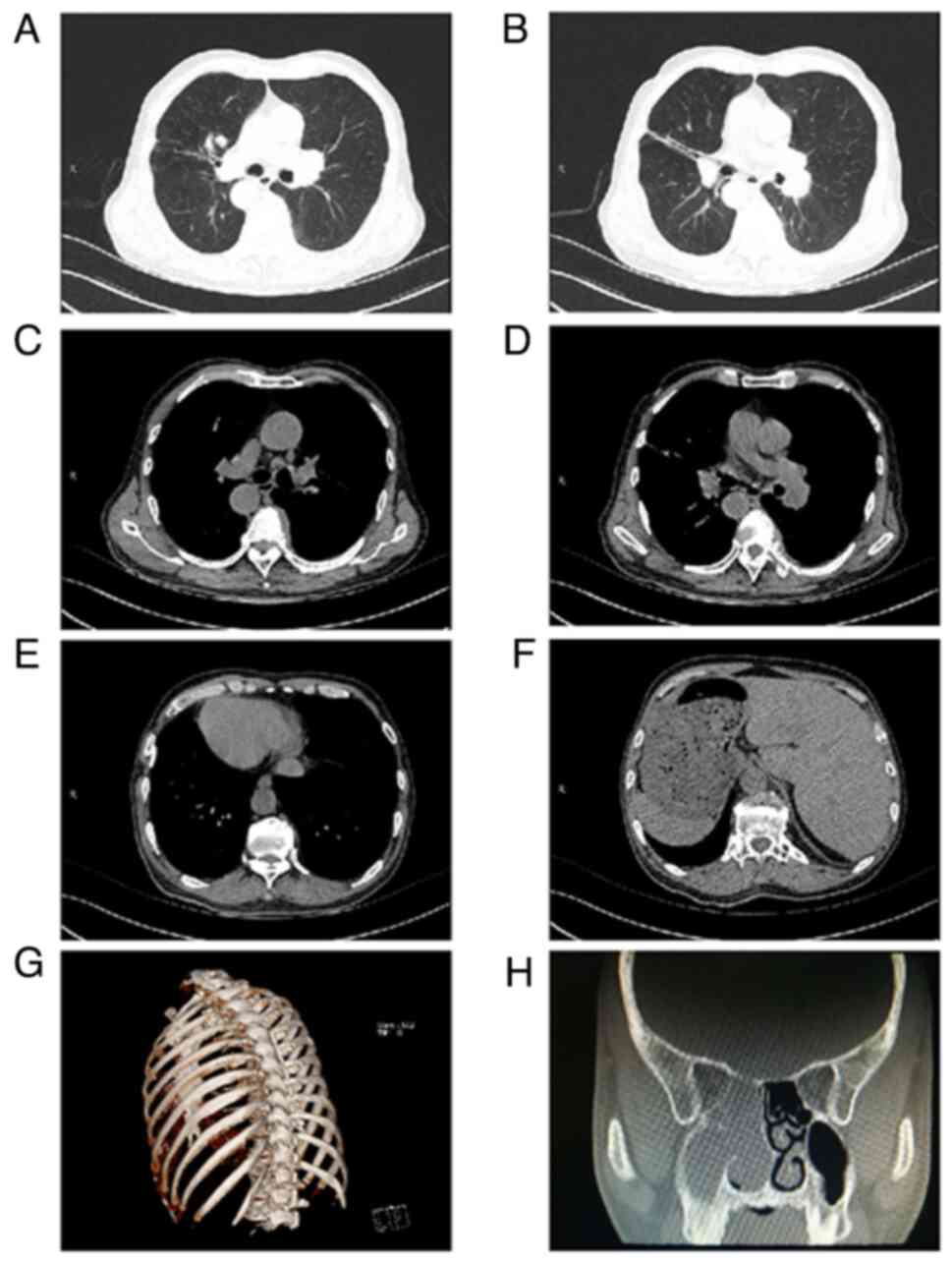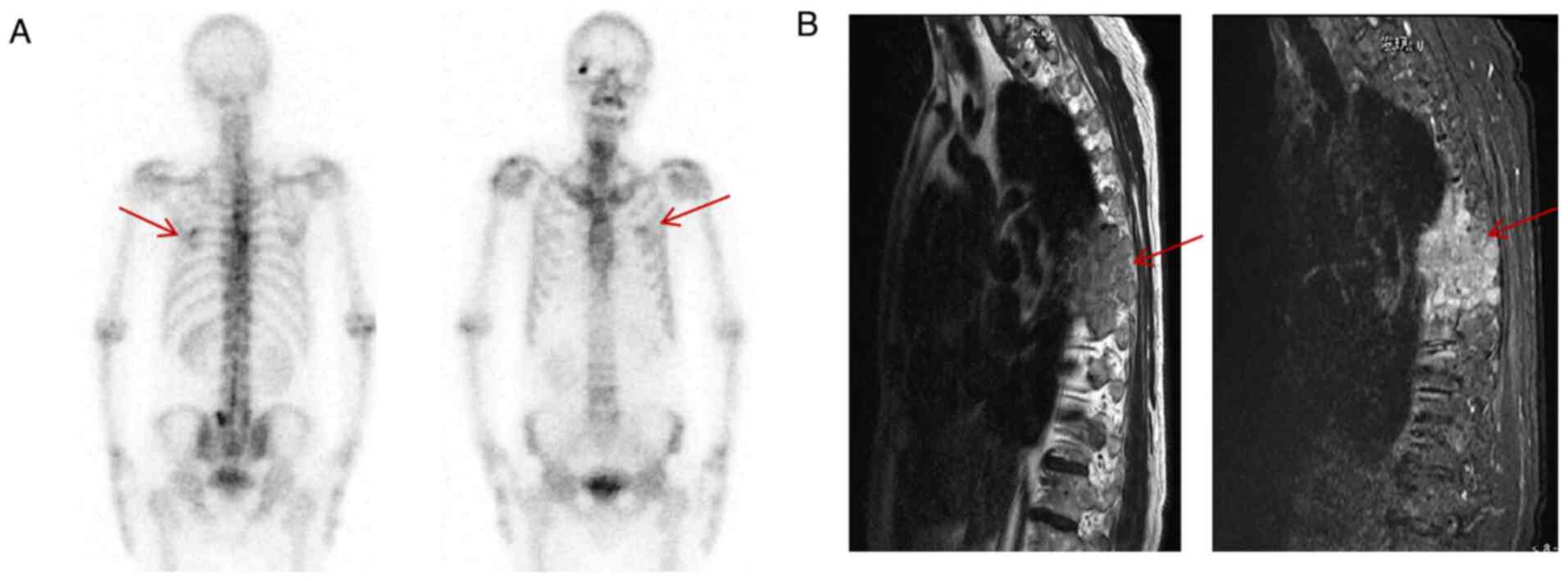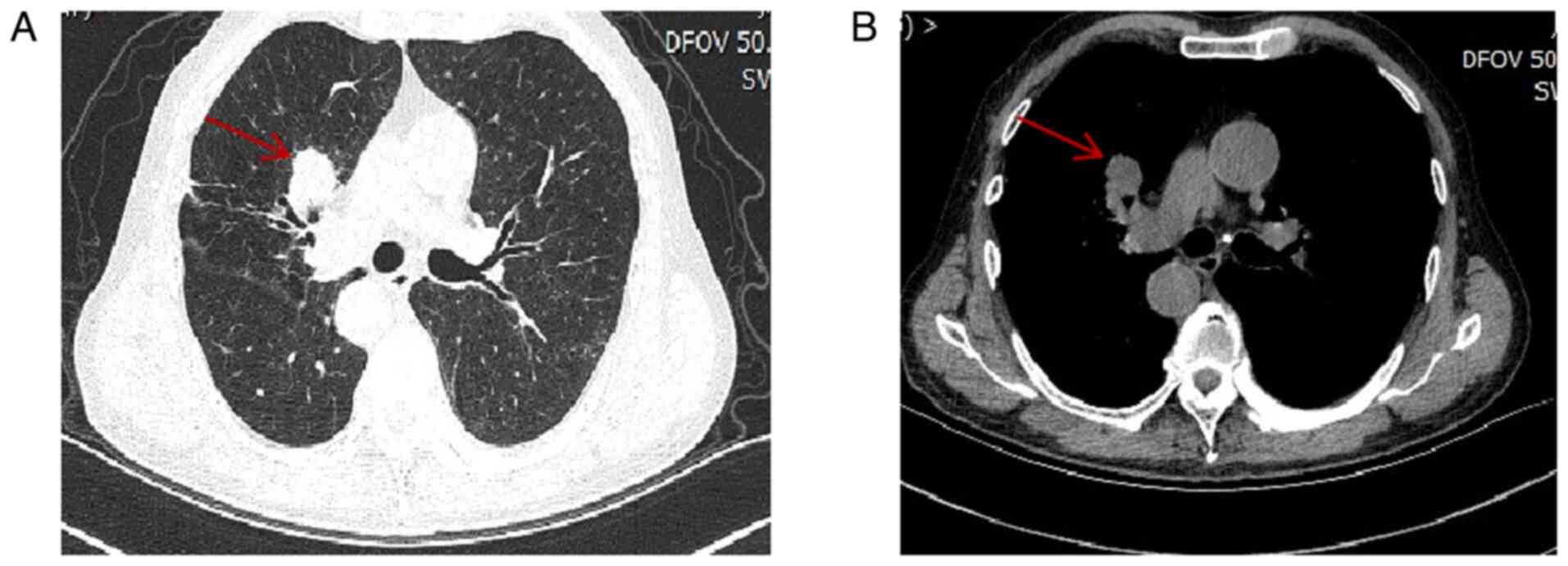Kartagener syndrome combined with small cell lung cancer: A case report and literature review
- Authors:
- Published online on: March 17, 2025 https://doi.org/10.3892/etm.2025.12848
- Article Number: 98
-
Copyright: © Zhou et al. This is an open access article distributed under the terms of Creative Commons Attribution License.
Abstract
Introduction
Kartagener syndrome (KS) is a rare autosomal recessive genetic disorder. In 1933, Kartagener linked visceral inversion, sinusitis and bronchiectasis as independent syndromes (1). In 1976, Pedersen et al (2) proposed that owing to the congenital lack of axial arms in the cilia throughout the body, there is a loss of motility, resulting in the retention of secretions and pathogens. This condition predisposes individuals to recurrent bronchiectasis and sinus lesions in the long term. In 1981, Sleigh (3) found that cilia were not completely immobile but exhibited abnormal movement, which was termed primary ciliary dyskinesia (PCD). PCD accompanied by visceral reversal is known as KS, and ~50% of patients with PCD have KS. KS is frequently accompanied by chronic respiratory symptoms, and when it worsens, it is easily misdiagnosed as an infection. In addition, atypical early imaging can easily lead to missed diagnoses and misdiagnoses of pulmonary malignant tumors. The present study reports a rare clinical case of KS complicated by small-cell lung cancer, which was initially misdiagnosed as a lung infection owing to atypical clinical symptoms and imaging findings. After a precise diagnosis, the patient was ultimately diagnosed with KS and received timely treatment. It is hoped that this case will draw the attention of clinical respiratory physicians to KS combined with lung cancer.
Case presentation
A 66-year-old male patient with a history of smoking (the patient smoked 20 cigarettes per day x 40 years, and thus he had a smoking index of 800), exhibited primary symptoms of cough, chest pain and intermittent fever for 4 months, admitted to the Department of Pulmonary and Critical Care Medicine of Jining No. 1 People's Hospital (Jining, China). Despite having received intermittent antibiotics for a lung infection at a local hospital, the patient's symptoms failed to improve and the chest pain worsened. Physical examination revealed normal vital signs, coarse breathing sounds in both lungs, and no dry or wet rales or pleural friction sounds. On percussion, the boundary of the cardiac dullness widened to the right and no pathological murmurs were heard. Laboratory tests revealed a normal white blood cell count (5.63x109/l; normal range, 4-10x109/l), normal neutrophil levels (3.94x109/l; normal range, 2.04-7.5x109/l), a normal procalcitonin level (0.05 ng/ml; normal range, 0-0.05 ng/ml), an elevated neuron-specific enolase level (48.96 ng/ml; normal range, 0-16.3 ng/ml) and an elevated carcinoembryonic antigen level (13.52 ng/ml; normal range, 0-5 ng/ml), as well as normal liver and kidney function, blood lipids and blood glucose. Electrocardiography showed a right-sided heart. Chest CT + 3D reconstruction of the ribs revealed chronic inflammation of both lungs, multiple bronchiectasis in both lungs, nodules in the upper lobe of the right lung, a flaky high-density shadow in the right main bronchus, bilateral pleural thickening, localized calcification of the right pleura and a right-sided heart with transposition of thoracic and abdominal organs (Fig. 1A-G). Paranasal sinus CT revealed right maxillary sinusitis, ethmoid sinus, nasal soft tissue shadow, polyps, deviated nasal septum, and bilateral middle and lower turbinate hypertrophy (Fig. 1H). The patient presented with right locus coeruleus, visceral inversion, sinusitis and bronchial dilatation and was diagnosed with KS. Clinical consideration of the patient as having KS, combined with the patient's previous long-term smoking history and the presence of a flaky hyperdense shadow in the right main bronchus, did not exclude the possibility of bronchial phlegm embolism, foreign body or obstruction. Bronchoscopy revealed normal bronchial tubes in the right lung. A polypoid neoplasm was observed in the opening of the upper lobe of the left lung, incompletely obstructing the lumen and spreading along the middle segment to the opening of the middle and lower lobes of the left lung, with necrosis on the surface, which was biopsied (Fig. 2A and B). Pathological and immunohistochemical analysis was performed in the Department of Pathology, Jining NO. 1 People's Hospital. The specimens were fixed in 10% neutral formalin, with conventional paraffin embedding, and sliced into 4-µm thick continuous sections. Light microscopy was used for observation. Hematoxylin (5 min) and eosin (2 min) staining of the pathological specimens was performed at room temperature. At the same time, the EnVision two-step method of immunohistochemistry was used according to standard protocols, with antibodies for cytokeratin 7 (CK7; cat. no. Kit-0021), CD56 (cat. no. R-0148-03), thyroid transcription factor 1 (TTF-1; cat. no. MAB-0599), synaptophysin (Syn; cat. no. R-0482-03), chromogranin A (CgA; cat. no. RMA-0548), aspartic peptidase A, (NapsinA; cat. no. MAB-0704) and lymphocyte-specific protein tyrosine kinase (LCK; cat. no. R-0347-03) (all pre-diluted; Fuzhou Maixin and Shanghai Changdao Biotechnology Co., Ltd.) The secondary antibody was from the Universal DAB Detection Kit [cat. no. 760-500; Roche Diagnostics (Shanghai) Co., Ltd.], which was a universal type. Cancer cells were detected in the bronchoalveolar lavage fluid, and H&E stain revealed heterogeneous epithelioid cells with dense cells, deeply stained nuclei and little cytoplasm. Immunohistochemistry revealed CK7(+), CD56(+), TTF-1(+), Syn(+), CgA(-), NapsinA(-) and LCK(+) results, confirming the diagnosis of small cell lung cancer (Fig. 2C-K). A complete extrapulmonary auxiliary examination suggested bone metastasis (Fig. 3A, B). Therefore, the following diagnoses were made: i) Small cell lung cancer of the left lung (extensive stage) and ii) KS. Small cell lung cancer is the most malignant type of lung cancer, is incurable and combination chemotherapy can only control the disease temporarily; the cancer will eventually progress (4). The patient had an ECOG performance status score (5) of 1, and according to the Chinese Primary Lung Cancer Diagnostic and Treatment Guidelines (6), the patient received a cisplatin/etoposide combination chemotherapy for 6 cycles and bisphosphonates treatment; the disease was controlled and the patient was rated as being in partial remission after the treatment according to Solid Tumor Response Assessment Criteria (7). However, half a year later, the patient's disease had progressed (Fig. 4), and the patient's family refused to continue the antitumor treatment due to side effects and financial concerns, and chose symptomatic supportive therapy instead. Through telephone follow-ups, it was revealed that the patient eventually passed away 1 year later owing to the progression of lung cancer.
Discussion
The patient was clinically suspected of having KS owing to recurrent cough, sputum production and fever, symptoms commonly attributed to infectious factors. However, the exacerbation of chest pain prompted admission to our hospital for further evaluation. Based on the clinical symptoms, the following differential diagnoses were considered: Pulmonary embolism, myocardial infarction, tension pneumothorax and aortic coarctation. 3D reconstruction of the ribs was performed with the aim of excluding fractures and other conditions. However, upon chest CT examination, small nodules and hyperdense shadows were observed in the patient's airways, suggesting the possibility of sputum embolus, foreign bodies and possible lung cancer. The patient lacked the typical pathognomonic features of lung cancer and no obvious mass on CT. The patient's condition progressed despite anti-infective treatment and the patient developed chest pain. This was different from the previously reported cases (8-10), and therefore, it is required to reconsider whether there was a combination of other diseases on the basis of KS. Thus, the patient's chest CT was repeatedly scrutinized and slight irregularities in the left bronchial wall, partial stenosis and characteristic wave-like changes were found. Therefore, it was deemed necessary to perform a bronchoscopy, revealing an abnormality in the left bronchus and a tissue biopsy was taken. Finally, pathological examination confirmed the diagnosis of small cell lung cancer. The patient's chest pain was attributed to a combination of small cell lung cancer and rib metastasis.
In conclusion, KS is typically characterized by recurrent respiratory infections. The present case highlights the importance of prompt action when anti-infective treatments do not yield satisfactory results in clinical settings and CT scans do not fully explain clinical symptoms, particularly in heavy smokers. Intensified examinations, including bronchoscopy, should be promptly pursued. This case serves as a reminder of the need for timely diagnosis of KS combined with small cell lung cancer, offering valuable guidance for clinical practice.
A literature review was then performed. KS is a subset of PCD, a rare autosomal recessive genetic disease with an incidence of ~ 1 in 30,000 (11,12). The pathogenesis of KS is not fully understood, but several studies have shown that the majority of causative mutations involve two genes, DNA H5 and DNAI1(13). Typical clinical manifestations include visceral transposition, bronchiectasis and chronic infectious sinusitis. Patients with KS may present with respiratory symptoms since early childhood, with recurrent fever, cough, sputum and blood in the sputum. The right heart and visceral transposition do not usually cause significant clinical symptoms. Imaging is the primary method used to confirm the diagnosis of KS. CT examination of the chest and abdomen can reveal visceral inversion and bronchial dilatation and determine whether they are combined with infection; additionally, CT of the sinus can identify sinus lesions. Treatment mainly focuses on preventing respiratory infections, including the use of antibiotics and pulmonary physiotherapy to prevent complications (12,14).
KS is not associated with age, sex or smoking history (11,12), whereas lung cancer, especially squamous lung cancer, is more common in older adults, men and smokers. There are limited reports on KS combined with small-cell lung cancer. In KS, the congenital absence of axial arms of the cilia lead to loss of mobility, causing the retention of secretions and pathogens, dysfunction of airway clearance, long-term stimulation of pathogenic microorganisms, chronic inflammation, and long-term and repeated exposure to chronic carcinogens, which ultimately result in the development of lung cancer (8-10). This is the main factor in lung cancer development reported in the previous literature. In the present case, the patient was at high risk of developing lung cancer due to being an elderly male and having a long history of smoking, which, combined with the presence of KS, likely contributed to the development of lung cancer. However, the exact effects of KS on tumorigenesis require further investigation. For the patient in this case study, respiratory infection symptoms were the primary concern, leading to ongoing anti-infective treatment. Owing to the prominence of these symptoms, the clinical signs of lung cancer were not obvious, potentially resulting in delayed diagnosis. Furthermore, small cell lung cancer is highly malignant, and despite a timely diagnosis, the prognosis of the patient in this case was poor, with the patient surviving only 1 year after diagnosis.
Acknowledgements
Not applicable.
Funding
Funding: This research was supported by the Key R&D Program of Jining (grant no. 2023YXNS243) and the Medical System Staff Science and Technology Innovation Program Project of Shandong (grant no. SDYWZGKCJHLH2023068).
Availability of data and materials
The data generated in the present study may be requested from the corresponding author.
Authors' contributions
JZ, LW and CQ contributed to the conception and design of the study. Data collection and analysis were performed by CB, JM and LH. The manuscript was written by JZ and CB. CQ confirm the authenticity of all the raw data. All authors read and approved the final manuscript.
Ethics approval and consent to participate
Not applicable.
Patient consent for publication
As the patient had passed away when the case report was prepared, written informed consent was obtained from the patient's daughter for the publication of potentially identifying images or data included in this article.
Competing interests
The authors declare that they have no competing interests.
References
|
Kartagener M: Zur Pathogenese der Bronchiedtasien. I. Mitte lung Bron chiektasien bei Situs viscerum inversus. Beitr Klin Tuberk. 83:489–501. 1933. | |
|
Pedersen H and Mygind N: Absence of axonemal arms in nasal mucosa cilia in Kartagener's syndrome. Nature. 5:494–495. 1976.PubMed/NCBI View Article : Google Scholar | |
|
Sleigh MA: Ciliary function in mucus transport. Chest. 80 (Suppl 6):S791–S795. 1981.PubMed/NCBI | |
|
Torre LA, Siegel RL and Jemal A: Lung cancer statistics. Adv Exp Med Biol. 893:1–19. 2016.PubMed/NCBI View Article : Google Scholar | |
|
Schnipper LE, Davidson NE, Wollins DS, Tyne C, Blayney DW, Blum D, Dicker AP, Ganz PA, Hoverman JR, Langdon R, et al: American Society of Clinical Oncology Statement: A conceptual framework to assess the value of cancer treatment options. J Clin Oncol. 33:2563–2577. 2015.PubMed/NCBI View Article : Google Scholar | |
|
Zhi X, Shi Y and Yu J: Standards for the diagnosis and treatment of primary lung cancer (2015 version) in China. Zhonghua Zhong Liu Za Zhi. 37:67–78. 2015.PubMed/NCBI(In Chinese). | |
|
Schwartz LH, Litière S, de Vries E, Ford R, Gwyther S, Mandrekar S, Shankar L, Bogaerts J, Chen A, Dancey J, et al: RECIST 1.1-update and clarification: From the RECIST committee. Eur J Cancer. 62:132–137. 2016.PubMed/NCBI View Article : Google Scholar | |
|
Horie M, Arai H, Noguchi S, Suzuki M, Sakamoto Y and Oka T: Kartagener syndrome with lung cancer and mediastinal tumor. Nihon Kokyuki Gakkai Zasshi. 48:375–378. 2010.PubMed/NCBI(In Japanese). | |
|
Zhou D, Tian Y, Lu Y and Yang X: Anatomical variants of pulmonary segments and uni-portal thoracoscopic segmentectomy for lung cancer in a patient with Kartagener syndrome: A case report. Gen Thorac Cardiovasc Surg. 69:1432–1437. 2021.PubMed/NCBI View Article : Google Scholar | |
|
Zhang J, Xiao Y, Bai M and Bian J: A rare case of Kartagener syndrome combined with lung cancer. Asian J Surg. 46:4801–4802. 2023.PubMed/NCBI View Article : Google Scholar | |
|
Ibrahim R and Daood H: Kartagener syndrome: A case report. Can J Respir Ther. 57:44–48. 2021.PubMed/NCBI View Article : Google Scholar | |
|
Tadesse A, Alemu H, Silamsaw M and Gebrewold Y: Kartagener's syndrome: A case report. J Med Case Rep. 12(5)2018.PubMed/NCBI View Article : Google Scholar | |
|
Pandey AK, Maithani T and Bhardwaj A: Kartagener's syndrome: A clinical reappraisal with two case reports. Egypt J Ear Nose Throat Allied Sci. 15:271–274. 2014. | |
|
Flume PA, O'Sullivan BP, Robinson KA, Goss CH, Mogayzel PJ Jr, Willey-Courand DB, Bujan J, Finder J, Lester M, Quittell L, et al: Cystic fibrosis pulmonary guidelines: Chronic medications for maintenance of lung health. Am J Respir Crit Care Med. 176:957–969. 2007.PubMed/NCBI View Article : Google Scholar |














